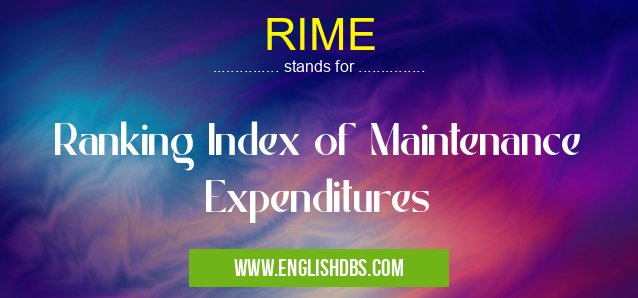What does RIME mean in UNCLASSIFIED
RIME (Ranking Index of Maintenance Expenditures) is a metric used to evaluate the maintenance costs of different infrastructure assets. It provides a way to prioritize maintenance activities and allocate resources effectively.

RIME meaning in Unclassified in Miscellaneous
RIME mostly used in an acronym Unclassified in Category Miscellaneous that means Ranking Index of Maintenance Expenditures
Shorthand: RIME,
Full Form: Ranking Index of Maintenance Expenditures
For more information of "Ranking Index of Maintenance Expenditures", see the section below.
- Ranking Index of Maintenance Expenditures (RIME) is a performance measure used to evaluate the efficiency of maintenance operations.
Definition
- RIME is a metric that indicates the level of maintenance expenditures required to maintain an asset or a group of assets.
Importance
- RIME helps organizations:
- Quantify maintenance costs
- Optimize maintenance strategies
- Identify areas for cost reduction
- Track maintenance performance over time
- It provides a basis for comparing the maintenance performance of different departments or facilities.
Calculation
- RIME is calculated as:
- (Total Maintenance Cost / Replacement Cost of Asset) x 100
Usage
- RIME is typically used in the following areas:
- Facility management
- Asset management
- Maintenance engineering
Benefits
- Using RIME has several benefits:
- Improves maintenance planning and budgeting
- Reduces maintenance costs
- Extends asset lifespan
- Improves asset reliability
Essential Questions and Answers on Ranking Index of Maintenance Expenditures in "MISCELLANEOUS»UNFILED"
What is RIME?
How is RIME calculated?
RIME is calculated by dividing the total maintenance expenditures for an asset by the replacement cost of the asset. The result is a dimensionless number that can be used to compare the maintenance costs of different assets.
What is a good RIME score?
A good RIME score is a score that is relatively low. A low RIME score indicates that the asset is being maintained in a cost-effective manner.
What are the benefits of using RIME?
RIME can help asset managers to:
- Prioritize maintenance activities
- Allocate resources effectively
- Make informed decisions about maintenance investments
- Improve the overall performance of infrastructure assets
How can I use RIME in my organization?
To use RIME in your organization, you will need to:
- Collect data on maintenance expenditures and replacement costs for your assets
- Calculate the RIME score for each asset
- Use the RIME scores to prioritize maintenance activities and allocate resources
Final Words:
- RIME is a valuable tool for organizations looking to improve their maintenance operations. By tracking and analyzing RIME, organizations can identify areas for improvement and optimize their maintenance strategies to reduce costs and ensure the efficient operation of their assets.
